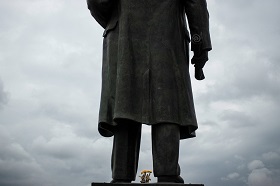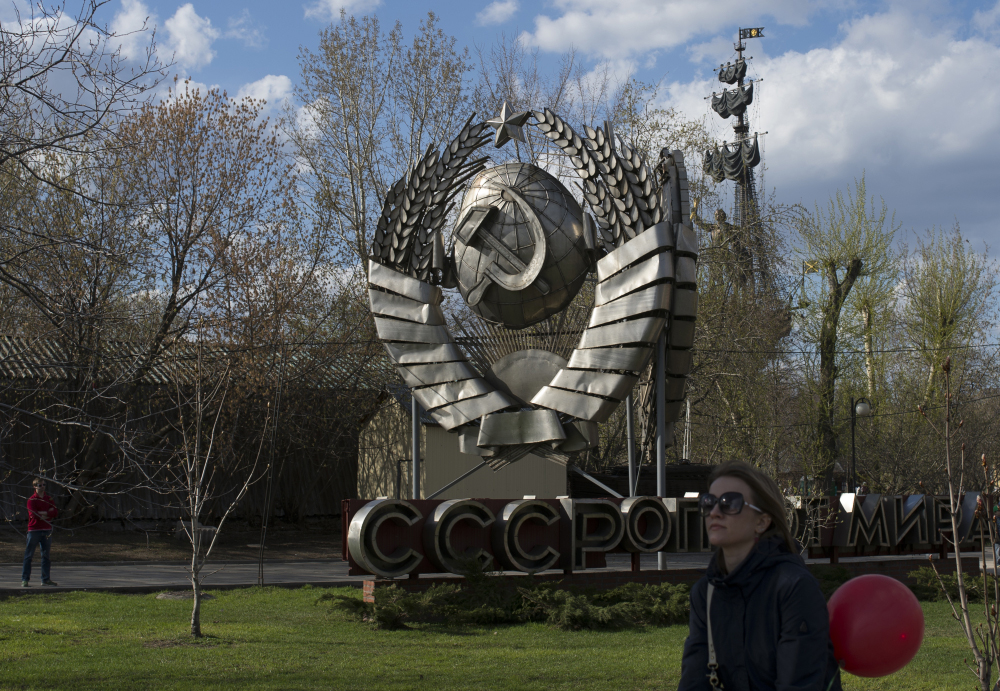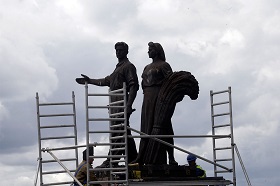The “Non-Deep” Causes of the Disintegration of the Soviet Union
In
Login if you are already registered
(votes: 7, rating: 4.43) |
(7 votes) |
Professor, Fudan University, Beijing Club for International Dialogue, Senior Fellow
The Soviet leaders made a series of crucial strategic and operational mistakes in carrying out the perestroika, which was another key factor in the decline of the central power. The Soviet leaders had disabled the existing vertical power system based on the party in order to avoid the resistance by the establishment of the party to the reform, but failed to build a new one instead. Its strikingly poor performance in proceeding with the reform and state management had resulted in catastrophic political, social, and economic consequences. The authority of the central government had been disappearing while the society dropped in chaos, the deficit worsened, life became harder, unsatisfaction of the people risen, and the ethnic sentiment and independent desire became stronger.
There were many opportunities for the central government to save the union, even in the last half year before the breakup of the union, but the central government was lacking in either political resolution or the ability to make any responsible decision for saving the union.
It should be noted that the three concepts are often mixed into one, specifically, the collapse of the Soviet Union, the dissolution of the Communist Party, and the failure of the perestroika. These three things were closely interrelated, but they are not one thing and cannot be confused and should not replace each other in explaining the fall of the union. Failure of reform would have serious consequences, but it is not the end of the union. The collapse of the Soviet Communist Party could formally have eliminated the Soviet Union, but it would not be equal to a disassembly of a unified country. Even if the Communist Party were disbanded, it was possible to keep the country united in a new form if the new regime that succeeded it was strong enough. The USSR was a good example itself, which was created on the ruins of the Russian empire by the Bolshevik party.
From a philosophical rather than a factual perspective, the collapse of the Soviet Union in 1991 was accidental, not destined. It means that the Soviet Union as a state did not reach the point of no return, having to disintegrate. It was standing at a crossroads and could go in different directions, but it was contingently pushed into the direction of dissolution.
This year marks the 30th anniversary of the breakup of the Soviet Union. Collapse of the Soviet Union and the subsequent independency of its former republics could be evaluated differently depending on the perspective, and its causes could be studied through different approaches and analytical frameworks. In this regard, much has been written about the “deep causes” of its breakdown. The author does not intend to dwell on these, rather resorting to the perspective of empirical observation to talk about its shallow causes, that is, the most direct cause of the breakup of the Soviet Union.
In exploring the deep reasons for the disintegration of the Soviet Union, the main analytical frameworks usually employed are references to the political model, ideological failure, economic unsustainability, arms race with the U.S., ethnic problems—in addition to a number of other explanations, such as the sharp fall of oil prices in the 1980s, the pervasive corruption in the society, overstretch of the Soviet empire so on.
Undoubtedly, all these factors had a significant effect on the process of dissolution of the Soviet Union and composed the general driving forces that finally lead to the disintegration of the Soviet Union. However, they are not the direct causes of its breakdown.
Did the political model break up the Soviet Union?

Russia’s Way of Being in the World, from Yesterday to Tomorrow
The Soviet system had many shortcomings, but these shortcomings were not direct factors to disintegrate the Soviet Union.
These shortcomings forced the Soviet Union to embark on the path of reform, or perestroika, in the process of which the Soviet Union ceased to exist. But it was not the model of the Soviet system, nor the reform, that destroyed the Soviet Union. It was the mistakes in the reforms that destroyed it.
The reform itself, or perestroika, was not only the right, but also the necessary choice for the Soviet Union, which was suffering from political, economic, and social stagnation. However, rightness of the reform does not mean that the strategy and tactics employed are correct. Reforms with good intentions are not certain to succeed, and reforms with poor strategy and tactics are doomed to failure. The failure of the reform says something there was wrong, but not necessarily that the reform was wrong.
The national autonomy system is the most important part of the Soviet system as regards ethnic relations. From a retrospective point of view, the national autonomy system had objectively provided the administrative, territorial, ethnic, and cultural basis for the post-Soviet republics once they gained independence. However, national autonomy is a system that is widely practiced all over the world. Not every state with a national autonomy system ended unsuccessfully. Under this system, the Soviet Union had maintained unity for 70 years as well. It says that the national autonomy system, being a favorable way to independence, does not necessarily result in the breakup of a state.
Many people believe that the collapse of the Soviet Union was the result of poor ethnic policies and relations. It is true that the Soviet Union had many problems in dealing with ethnic relations, but it also had successes. Of the Soviet Union’s 15 republics, 14 were ethnic minorities that accounted for nearly 50 percent of the country’s total population. They believe in different religions, with six republics adhering to Islam. The complexity and difficulty of dealing with national problems in the Soviet Union can easily be imagined. The Soviet Union’s greatest success was made through the notions of “Soviet” and “Soviet people”, a common identity for all the republics and all the people (except for the Baltic states). Russian was popularized as a common language, secularization entrenched itself into the society, different ethnic lifestyles could be accommodated, people of different ethnic groups could work and live together normally, the sense of national differences was not so strong in common public life, intermarriage between different ethnic groups was also common practice. True, ethnic relations in the Soviet Union were not perfect, particularly from the perspective of the national minorities, but they were largely normal. It was the political, economic and social problems that pushed the Soviet Union to reform rather than the ethnic one. They were not the direct factors that destroyed the Soviet Union.
Did the ideological failure and political “betrayal” bring down the Soviet Union?
It is mainly a view held by people who looked at the issue from an ideological perspective. They believe that the collapse of the Soviet Union was because the leaders of the reform betrayed Marxism, the socialist system and the communist ideals. Surely, this is an ideological explanation of collapse of the Soviet Union.
The collapse of the Soviet Union had no direct link with its ideological system and its state system. A state may be unified or split no matter what ideology it believes in, whether communism or capitalism. As far as the state system is concerned, whether under autocracy or democracy, it is possible to remain united or break apart. A state may also maintain unity or split, whether a royalist or a revolutionary party is in power.
It is unreasonable to think that the Soviet Communist Party’s betrayal of socialism led to the disintegration: socialism is not a theory or a principle of national unification, and adherence to or betrayal of socialism does not mean a choice between unification and disintegration, nor does it necessarily lead to the breakup of a country.

Only Now Do We See the Real Disintegration of the USSR
So, attributing the collapse of the Soviet Union to political treachery makes no sense in theory or in practice. The tsarist Russia was the originator of the Russian empire, and the Soviet Union was the successor of the Russian empire. There was no fundamental difference between the two in maintaining the unity of the “empire”. Even betraying the old system did not mean giving up the “empire”. Gorbachev reformed the Soviet Union with no intention of destroying it. His problem with keeping the Soviet Union together was not in “betrayal” but in losing control of the process he had ignited.
Did economic problems break up the Soviet Union?
The Soviet Union collapsed in a state of great economic crisis, which gave people the impression that economic decline led to the collapse of the Soviet Union and made it popular to judge the demise of the Soviet Union from an economic angle.
This judgment seems to be supported by the facts, and seems to be in line with the general logic. Moreover, economic problems were indeed an important background for the disintegration of the Soviet Union, however, it was not the direct cause of the breakdown of the Soviet Union as well.
Economic decline did aggravate political conflicts and social discontent in the Soviet Union, but it led to intensified political struggles and social disorder rather than the breakdown of the Soviet Union. Independence is primarily a political appeal rather than an economic demand. Indeed, the economic factor was often serving as a justification for independence by the republics, regardless of the economic status of the republic. The richer republics said they were richer than the others, so it was unfavorable for them to stay with the union, arguing for independence. The poorer republics argued that they were poor because they were exploited by the union, arguing for independence, too. In fact, it was just an excuse for political mobilization. Except for the Baltic states, most of the republics were less developed than Russia, and many of them were subsidized by the central government. For the elites of many republics, economic difficulties were mainly a tool for their political pursuits, but not the direct reasons driving them to independence.
Shortly put, economic conditions are not directly related to the division of the union. With the common identity of the Soviet Union existing, economic problems could ruin the state politically and socially, but not necessarily destroy the union. Many countries undergoing economic chaos have not been divided for a long time. China is a typical example in this regard. The so-called ten-year Cultural Revolution (1966-1976) had brought the country to the edge of economic collapse, but China’s unity was not shaken. Other countries, such as Yugoslavia, though doing not so bad economically, still imploded.
Did the arms race bring down the Soviet Union?
Arms competition with the United States is also often blamed for the collapse of the Soviet Union. During the Cold War, the Soviet Union had been engaging in decades-long arms race with the United States. In order to maintain the military balance with the United States, the Soviet Union spared no effort to develop military industry and manufacture advanced weapons. Notwithstanding the conditions of its gross national product (GNP) being far smaller than that of the United States, the Soviet Union’s military spending was not lower, and even higher in some cases, than that of the U.S. According to different estimates, during the Cold War the Soviet military spending amounted to 15% of GDP, or even higher. This caused the malformation of the state’s economic structure, with the heavy industry too much oversized, the light industry significantly underdeveloped, which resulted in a serious deficit of life commodities and discontent of the population.
The arms race was indeed one of the important factors in the breakdown of the Soviet Union, but its impact was indirect as well. This factor could in a sense be regarded as belonging to the economic domain, since it was ultimately reflected in exhausting the state’s resources and an economic decline. The arms competition had been burdening heavily on the Soviet economy and prompted reforms, but it did not directly lead to the collapse of the Soviet Union. People’s dissatisfaction was targeted to the life and social problems, but not to the union system, and it did not raise the appeal to dissolve the union. On the other hand, the strong military strength of the Soviet Union ensured the military security of the Soviet Union and made the Soviet people proud of it.
Did ethnic issues break up the Soviet Union?

Hybrid Power and the Real Russian Realists
Of all the arguments, the argument that ethnic issues destroyed the Soviet Union is the most logical and explanatory, because the disintegration of the Union was inseparable from the independence of the republics. However, the ethnic issues are still not the direct cause of the disintegration of the Soviet Union.
There were 15 republics in the Soviet Union, and the behaviors and influence of these 15 republics in the process of the collapse of the Soviet Union needs to be examined separately.
The common perception is that all the republics struggled firmly to break free of the Soviet Union and become totally independent states, which eventually broke up the union, but this was not entirely the case.
The Baltic states of Latvia, Lithuania and Estonia were in the vanguard of the independence wave, but they were a special group of republics. They had merged with the Soviet Union only during World War II, and their membership as the republics of the Soviet Union had never been recognized by the West. These three countries were also the republics least of the “Soviet style”. I travelled to Latvia, Lithuania, and Estonia late in 1980s while studying at MGIMO and I found the experience being as if I travelled to foreign states and not around the Soviet Union. Because of their special historical background, the three Baltic countries had the strongest appeal for independence and they were resolute independents.
With very small size and special historic background, the relations of the three Baltic states with the Soviet Union were different in common perceptions both inside and outside the Soviet Union, so, even if they became independent, it could be seen as a change of the territory of the Soviet Union, but not as the dissolution of the state, which had existed long before the three countries were incorporated into the Soviet Union.
In other words, the independence of these three states did not determine the existence of the Soviet Union. Their influence was mainly to stimulate other republics and set a precedent for independence.
The three Caucasus countries of Georgia, Azerbaijan, Armenia, as well as Moldova, all have argued for independence, with Georgia, Armenia, Moldova having refused to participate in the national referendum on a new union treaty in March 1991. However, these four republics were mainly followers of the trend rather than its leaders. Given the fact that the main trend turned to the direction of maintaining the union, they would most probably go with the tide rather than against it. It could be predicted that if the new union treaty were signed as planned on August 20, 1991, these countries would eventually join it.
The five Central Asian republics of Kazakh, Uzbek, Kyrgyz, Tajik and Turkmen did not demand independence in the sense of international law. The plot by Russia, Ukraine, and Belarus to dissolve the Soviet Union went on behind their backs. Kazakh President Nursultan Nazarbayev was on his way to sign the new union treaty when the presidents of Russia, Ukraine and Belarus signed the treaty on Belovezh to dissolve the union. The initial reaction to the collapse of the Soviet Union in the Central Asian republics was not joy but bewilderment and even disappointment. Support for the retention of the Union was also highest in Central Asia among all the republics, with 95 per cent in favor of keeping the union in the referendum of March 1991.
The decisive forces in the collapse of the Soviet Union were Russia, Ukraine, and Belarus. These three Slavic nations formed the bulk of the Soviet Union in terms of politics, economy, military forces, land, and population. Of the three, Ukraine was seen as the most committed to independence, and played a key role in their decision to dissolve the Soviet Union. But the interesting thing is that 90 per cent of the electorate voted in favor of independence in the referendum on Ukrainian independence held in December 1991, while only nine months earlier, in the national referendum in March 1991, 70.5 per cent of the Ukrainian electorate voted in favor of retaining the union and 80.2 per cent in favor of Ukraine joining the Union of Sovereign States. This suggests that the mood of most Ukrainians changed rapidly only in the second half of 1991, and until shortly before the collapse of the Soviet Union they had not yet pressed for independence.
In a nutshell, although the movement for national independence was soaring late in the 1990s, except for the three Baltic republics, the other republics were still in the state of ambiguity. It could be demonstrated by the result of the national referendum on whether to keep the Soviet Union in March 17, 1991. Georgia, Armenia, Moldova and the three Baltic republics did not vote in the referendum. In the rest of the republics, 77% of the residents voted in favor of keeping the Union. Thus, the main body of public opinion in the Soviet Union was still on the side of maintaining the Union, and the process of the Soviet Union’s disintegration was not irreversible at the time.
In a sense, the eventual independence of the republics was the result of, rather than the cause of, the political process that led to the collapse of the Soviet Union. As for the sharp decline in fiscal revenue caused by the collapse of oil prices, political corruption and other social problems, all of them may have played a role in the development process of the Soviet Union’s collapse, but it is even more far-fetched to directly link them with the collapse of the Soviet Union.
What was the immediate cause of the collapse of the Soviet Union?

Goodbye Post-Soviet Space?
No doubt, it was not one but the combination of many factors—political, economic, ethnic, military and others—that brought about the disintegration of the Soviet Union. Tracing back, the seeds for secession could be found in all these areas, and as deeply as we like. They made up the environment and conditions under which the process leading to the collapse of the Soviet Union proceeding. However, it did not mean that the existence of these seeds made the Soviet Union inevitably collapse.
So, what were the immediate causes of the collapse of the Soviet Union? The answer is the paralysis of the central government of the Soviet Union.
No matter what factors came into play, whether they had to do with the political model, economic crisis, arms races, or ethnic conflicts, the Soviet Union would not have collapsed if the central power had been powerful and effective. In other words, so long as these factors are not allowed to threaten the authority of the central power of a state, the union will not collapse. In the end, it was the paralysis of the central government that led to an upsurge of the wave of national independence, the loss of ability for the central government to control the situation and the eventual disintegration of the union.
It was the power struggle between the central government and the republics rather than the problems with the political system, ideology, or the economic decline and ethnic tensions, that paralyzed the central power of the union. To be specific, the heaviest blow to the central government’s authority came from its largest republic: Russia.
It’s obvious that Russia played a leading role in paralyzing the central government. In order to seize power, Russia’s leaders did not hesitate to destroy the central government, so that the central power could be transferred to the hands of the leaders of the republic. As the main nationality of the Soviet Union, Russia had put itself in a self-imposed exile and demanded independence from the union, in which it was the dominant part and, in a sense, it was even itself. Rather than pulling back the republics that wanted to leave the Soviet Union, it encouraged them to go further, seize as much power as possible from the center, and discard them as an economic burden.
Claim by the main nationality for independence from an empire created by itself is rarely seen in history. It is not only a great wonder of the history but also a unique feature of the disintegration of the Soviet Union.
The Soviet leaders made a series of crucial strategic and operational mistakes in carrying out the perestroika, which was another key factor in the decline of the central power. The Soviet leaders had disabled the existing vertical power system based on the party in order to avoid the resistance by the establishment of the party to the reform, but failed to build a new one instead. Its strikingly poor performance in proceeding with the reform and state management had resulted in catastrophic political, social, and economic consequences. The authority of the central government had been disappearing while the society dropped in chaos, the deficit worsened, life became harder, unsatisfaction of the people risen, and the ethnic sentiment and independent desire became stronger.
There were many opportunities for the central government to save the union, even in the last half year before the breakup of the union, but the central government was lacking in either political resolution or the ability to make any responsible decision for saving the union.
It should be noted that the three concepts are often mixed into one, specifically, the collapse of the Soviet Union, the dissolution of the Communist Party, and the failure of the perestroika. These three things were closely interrelated, but they are not one thing and cannot be confused and should not replace each other in explaining the fall of the union. Failure of reform would have serious consequences, but it is not the end of the union. The collapse of the Soviet Communist Party could formally have eliminated the Soviet Union, but it would not be equal to a disassembly of a unified country. Even if the Communist Party were disbanded, it was possible to keep the country united in a new form if the new regime that succeeded it was strong enough. The USSR was a good example itself, which was created on the ruins of the Russian empire by the Bolshevik party.
From a philosophical rather than a factual perspective, the collapse of the Soviet Union in 1991 was accidental, not destined. It means that the Soviet Union as a state did not reach the point of no return, having to disintegrate. It was standing at a crossroads and could go in different directions, but it was contingently pushed into the direction of dissolution.
(votes: 7, rating: 4.43) |
(7 votes) |
Putting the State Together Again and External Assistance: Losses or Gains?
Hybrid Power and the Real Russian RealistsThe project of post-Soviet Russian Realism needs a selective, critical reintegration of elements of Soviet thought, updating and upgrading them as befits the 21st century
Russia’s Way of Being in the World, from Yesterday to TomorrowThe secret of US soft power is that it has never given up the desire to lead and the role of leadership
Only Now Do We See the Real Disintegration of the USSRThe UC Interview Series: Andrey Kortunov




